
Showmanship is your method of presenting an animal in the best way possible to the judge.
Good showmanship takes a lot of time, effort and practice.
Always remember, however difficult it may seem, to maintain a positive attitude no matter where you are placed.
Also, make sure you watch experienced show people in action – there is no better way of picking up many useful tips.
At home
Your showmanship training will initially start at home.
Firstly, you will need to ensure that your animal is halter trained. A basic rope or nylon halter is adequate for this purpose.
If you have never halter trained an animal before, it is important that you have someone experienced to help.
To start, tie the animal up for short periods every day while brushing the animal, thus getting it used to the halter and your presence. Do not leave the animal unattended for any length of time during this initial period of training.
Once the animal has become used to the halter you need to train it to walk, stop and place its legs accordingly.
While training, it can be useful to have a radio playing to help get the animal used to different noises and therefore help prevent the animal from spooking on show day.
In the couple of weeks before show day, feed your animal out of a rubber tub and water it out of a bucket instead of the normal feeding troughs. This will ensure that the animal is used to the different feeding and watering methods that you will use at the shows.
Sometimes, if it is available, it helps to have a little sugar beet pulp with you at the shows to sprinkle in the drinking water to encourage your animal to drink.
Showing equipment
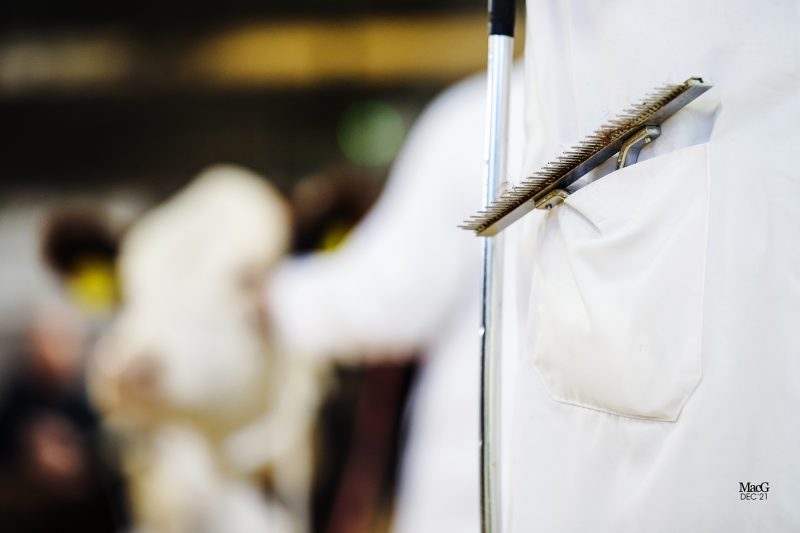
In addition to the standard grooming equipment, feed and bedding (the latter normally provided) you will require a few items specific to show day.
Curry comb – to groom your animal’s hair after the judge or another animal has brushed against it. This comb should be placed in your back pocket with the comb’s teeth facing your body.
Show stick – to place the animal’s feet, keep it calm by scratching its belly, keep its tail down and keeping the topline straight. It is sometimes needed to keep your animal from walking too fast, by holding the show stick horizontally in front of the animal’s nose. You will need a show stick that is long enough to reach the animal’s hind feet but not too long making it difficult to use. There are numerous kinds of show sticks available so make sure you choose one that you feel comfortable with.
Leather show halter – the usual halter for the show ring. The nosepiece should be placed approximately mid-way between the eyes and nose of the animal. These halters are adjustable so, by trial and error, find the right fit for each animal. The leading rope/strap should not be too long neither dragging the ground or wrapped around your hand.
When leading the animal, the rope/strap should be at least 10 to 15cm off the ground.
Exhibitor appearance
Dressing appropriately is a very important part of good showmanship.
You should dress neatly and cleanly. In this country, the general code of practice is that all exhibitors wear white coats.
It is certainly a good idea to wear overalls when washing your animals before showing so as to keep your clothes clean before entering the show ring.
Never wear baseball caps in the show ring, shorts nor wellingtons unless absolutely necessary. The best footwear are sturdy leather boots or shoes. Steel toed footwear is advised, in case you get stepped on.
Do not wear any attire that identifies the herd from which the animal you are showing comes from.
Finally, so as to help stewards and spectators alike, ensure the animal’s neck number, which is sometimes worn by the exhibitor, is clearly visible at all times.
Before entering the ring
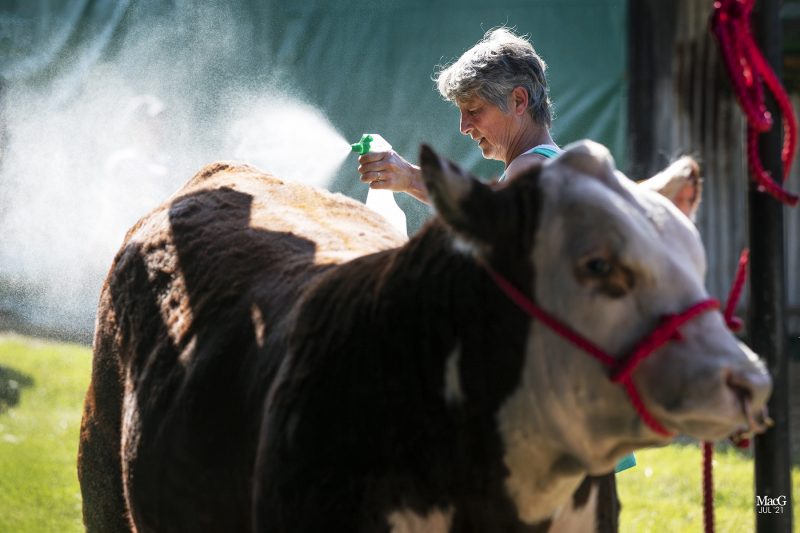
Take your animal for a walk, familiarising yourself with the show ring.
Make sure you are lined up in the collecting ring/area before your class is due into the show ring.
It is important not to arrive late into the show ring which causes disruption for those already parading and disturbs the judge who is likely to place late animals lower down the class.
Try not to be nervous or rushed, as this can really affect the animal you are showing, which may not co-operate if you show signs of being flustered.
Ensure that your animal is wearing its show halter, that you have your show number clearly visible and that you are armed with your curry comb and show stick.
Into the show ring
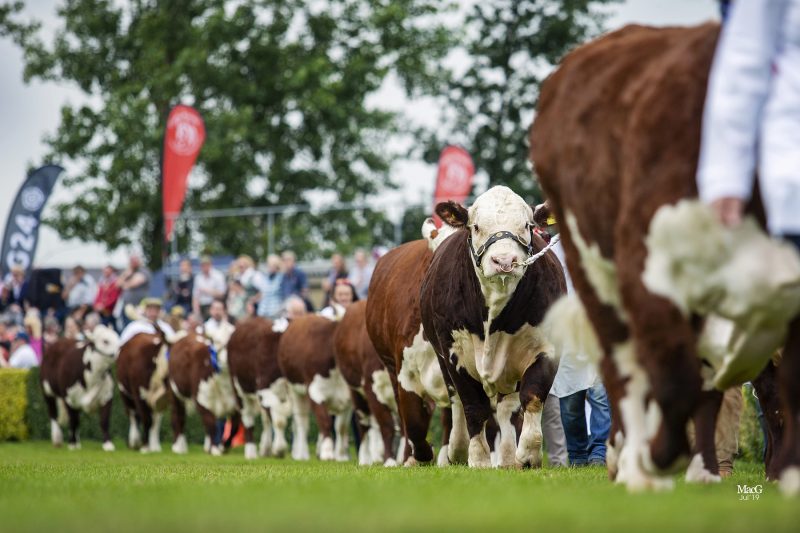
In advance of your class or classes, make sure you have identified the judge and ring steward. When entering the ring in animal age order, oldest to youngest, you will be directed by the steward. Exhibitors usually move in a clockwise direction for one or two circuits followed by each entry being walked to and away from the judge.
Normally they will then be lined up in age order so that the judge can handle and appraise each entry. Then the animals will be paraded again, allowing the judge to draw the entries into their order of placings.
At all times, whether circling the ring or when stationary, divide your attention equally between the judge, steward and your animal.
When you are circling the ring, make use of the entire space available to you but leaving room between your animal, the outside of the ring and the other animals behind and in front of you.
If an animal in front is not moving when it should be, twist its tail gently to help the exhibitor in front of you. Never pass other exhibitors or animals unless instructed to do so by the judge or steward.
If your animal is walking too fast, slowly raise your show stick horizontally in front of its nose, but at no time should you hit your animal.
Always when parading, and when in the line-up, keep your animal’s head up.
When the ring steward advises you to stop, bring your animal to a halt in the area indicated. Try to avoid any uneven ground or holes in the ring as this may make your animal less appealing to the eye.
As you stop, turn to face your animal, smoothly exchanging the leading rope/strap in your right hand for your show stick in your left hand. You should now be facing your animal with the leading rope/strap in your left hand and show stick in the right.
If possible, when stopping your animal try to place its front feet on slightly higher ground and approximately square. If the front feet are already close to being placed correctly this will save time in setting up the animal. Don’t forget to keep your animal’s head held high.
Use your show stick to scratch your animal’s belly a couple of times to calm it, then begin to place its feet. Try to set your animal up as quickly and smoothly as possible. Place the rear feet first and then the front feet. Normally you will be lined up side-by-side. Place the hind feet squarely under the animal, like the legs on a table, so that your animal appears as thick as possible through its hindquarters.
To move a hind foot backwards, push slightly on the halter and use your show stick to apply pressure between the toes of the hind foot. To move a hind foot forwards, pull forwards slightly on the halter and use the show stick to apply pressure underneath the dewclaw.
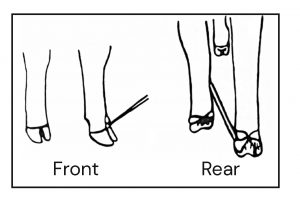
To place front feet, you may use either your own feet or the show stick. The same pressures on the halter and feet you used to set the rear feet will also set the front feet. When the animal is set up, begin scratching its belly again with the show stick. This should be a slow, relaxed motion.
It is now, when the animal is standing perfectly and calmly in the ring, you will realise all that practice at home is paying off.
Always make sure you keep an eye on both the judge and steward as either one of them may signal you to move your placing in the class at any time.
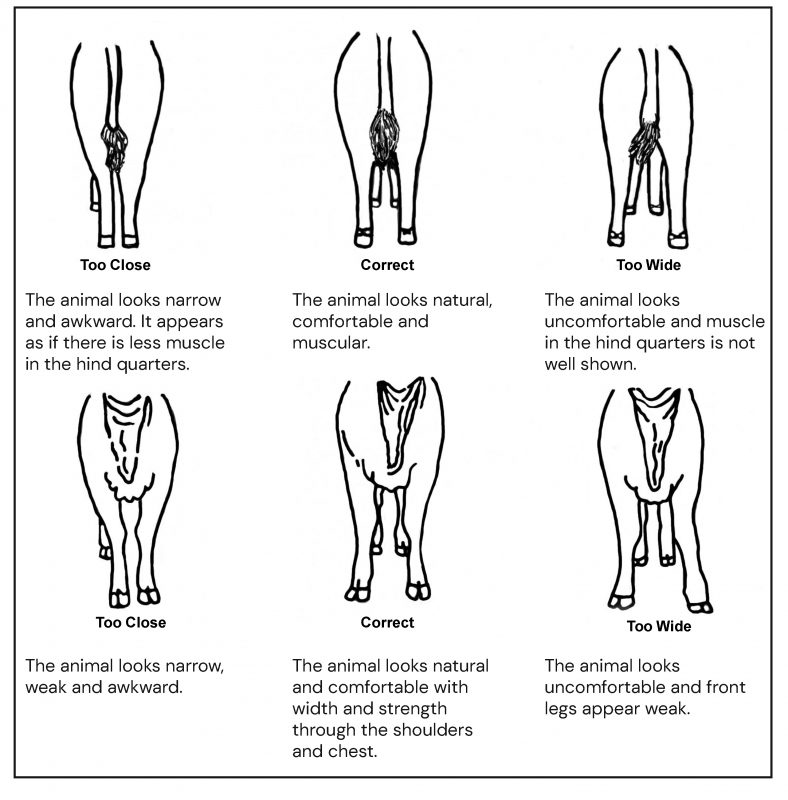
If you miss your signal to pull into position, the judge may choose to place another animal to stand higher in the class than yours, so it is important that you pay attention at all times.
Ensure your body never blocks the judge’s view of your animal. It is, however, perfectly in order to move slightly to make sure the judge has a clear view of your animal.
If the judge, or another animal, ruffles your animal’s hair use your curry comb in your back pocket to fix it but only when the judge has moved on to the next animal.
Changing positions
Once you are placed, the judge may change their mind and require you to switch places with another animal. This may also be a test during a showmanship/handlers competition.
Always make clockwise turns, moving in front of your animal’s nose and try not to walk your animal between the judge and the rest of the class.
If you are switching places with another animal, the lower placed animal should move out first. You can also pull your animal out of the line-up if it is misbehaving and reset into the same position. The diagrams below are examples of moving positions.
In a showmanship/handlers competition you may be asked to switch animals with another exhibitor. Before taking the halter of the new animal, try to quickly find out basic information about the animal (such as age, weight, sire, etc.). It also helps to take note of the animal’s strengths and weaknesses as the judge may ask you what you would change about the animal.
Finally, always remember to keep a positive attitude throughout your time in the show ring. Never give up on presenting your animal to the best of your ability, no matter where you are placed in the class.